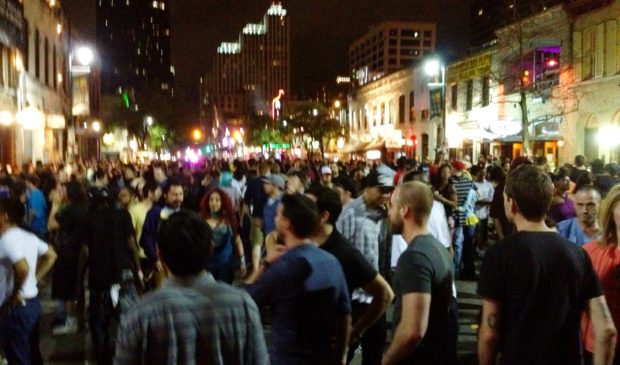Safer Sixth Street memo pushes new cameras, advises against gun buyback
Tuesday, May 24, 2022 by
Chad Swiatecki The city is moving ahead with several new components of last year’s Safer Sixth Street initiative, with police, fire and emergency services staff already using a new staging area on Neches Street intended to improve response times for medical needs and “no-notice” events.
In a memo released last week, Joe Chacon, chief of the Austin Police Department, and Denise Lucas, director of Development Services, updated City Council on the public safety and programming steps involved in the effort to reduce crime and acts of violence in the district.
Council passed the initial batch of Safer Sixth Street actions last summer after a mass shooting that injured more than a dozen nightlife patrons and left one tourist dead. In the months since, there have been more than a dozen other shooting injuries and one other death. A follow-on resolution in March provided more actions for police and other staff to take, including improving the network of cameras throughout the district.
The memo offered two options. The first was an $898,187 plan that would replace all existing cameras in the district (as well as those in the Rundberg area) and add cameras in 13 new locations, as well as create a dedicated broadband network and move the Real Time Crime Center to a new location in anticipation of the eventual closing of the downtown police headquarters.
The second option, costing $193,000, would add the 13 new cameras downtown with no replacements and a delay in moving the RTCC, which would need to take place in the future at a possibly higher cost.
In response to Council asking for information on a possible gun buyback program, the memo advises against that step.
Based on data from a pair of gun buyback programs run by the city in 2010 and 2011, Chacon said another buyback program would likely not have a significant impact on street crime. While the programs, which cost $70,000 total to run, brought in 735 weapons, he said most of the firearms were unwanted guns gifted or bequeathed to family members.
The effectiveness of the programs was possibly undermined by the fact that private buyers set up outside the exchange centers were offering more than the $100 and $200 gift cards the city had available as an incentive.
A no-questions-asked gun surrender program started in 2020 and operated for one quarter before being suspended due to concerns over the Covid-19 pandemic. That program yielded 65 firearms and more than 1,000 rounds of ammunition, but Chacon wrote that most of those unwanted guns were unlikely to be involved in the kinds of violent crimes the city is specifically interested in stopping.
He wrote: “If the goal is to reduce gun violence and associated crime, gun buybacks are viewed as ineffective, as research suggests that firearms turned in by the public are the least likely to be associated with gun-related crimes and violence, and no empirical research has shown significant changes in gun-related crimes due to these programs.”
On the programming side of the effort, the city is moving toward the creation of a pilot program that would allow for streetside activations such as outdoor seating for dining and other activities. When the memo was being drafted, staffers had decided on the criteria for the program, with plans to implement it in the coming weeks.
Those activations are a step toward promoting entertainment options along Sixth Street other than the many high-volume shot bars that operate mostly during late hours on weekends.
Related to those establishments, the memo notes Council is examining taking a “strong stance” against businesses with a history of repeated violent incidents by their customers. The Law Department briefed Council on its options during an executive session in April, with a follow-up confidential memo.
Photo by Marlon Giles, CC BY-SA 3.0, via Wikimedia Commons.
The Austin Monitor’s work is made possible by donations from the community. Though our reporting covers donors from time to time, we are careful to keep business and editorial efforts separate while maintaining transparency. A complete list of donors is available here, and our code of ethics is explained here.
You're a community leader
And we’re honored you look to us for serious, in-depth news. You know a strong community needs local and dedicated watchdog reporting. We’re here for you and that won’t change. Now will you take the powerful next step and support our nonprofit news organization?









